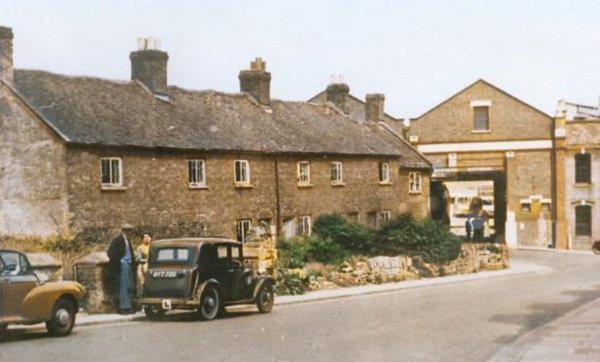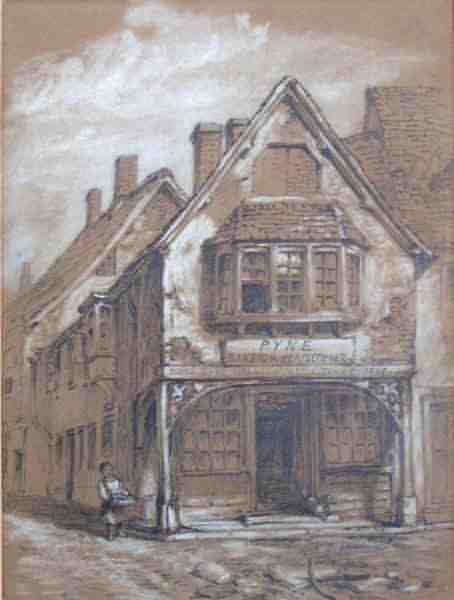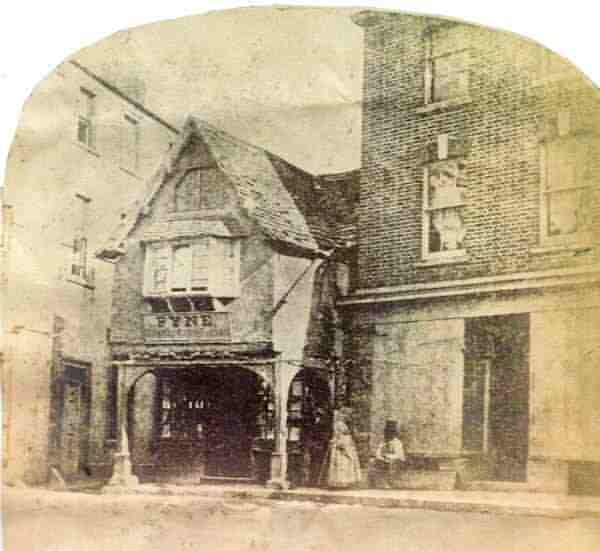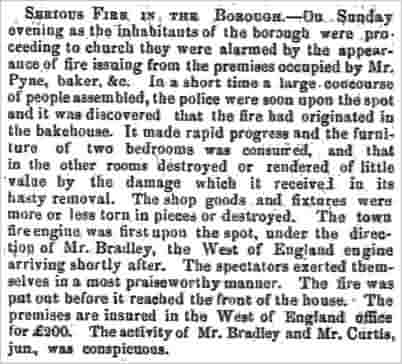Yeovil People
Charles H Pyne
Baker of the Borough
Charles H Pyne was born in Sparkford at the beginning of 1811 and baptised at the church of St Mary Magdalene, Sparkford, on 17 February 1811. Charles was the eldest of the six children of Samuel V Pyne (1786-1851) and Elizabeth née Chard (b1786). Samuel and Elizabeth's children, all born in Sparkford, were Charles, John (1812-1848), Jane (b1815), Samuel (1818-1819), Elizabeth (b1802) and Samuel (1825-1828).
Around 1835, probably at her home church of St James, Preston Plucknett, Charles married Charlotte Leach, the daughter of George Leach and his wife Jane. They were to have six children, all born in Yeovil; Harriett (b1839), Mary Ann (b1841), Elizabeth (b1843), John (b1845), William (b1848) and Jane (b1850).
Charles and Charlotte set up home in Yeovil and in the 1841 census they were listed living in South Street with their three eldest children and a servant girl. Charles gave his occupation as a glover. By the time of the 1851 census, Charles had moved his family to a cottage in Reckleford, adjacent to Goldcroft (see Gallery), now expanded to six children. Charles gave his occupation as a glove cutter while both Charlotte and 12-year-old daughter Harriett were glove sewers.
During the next decade, Charles changed occupations and became a baker, setting up his bakery, at least by 1861, in one of Yeovil's oldest buildings known as Under Bow, or simply The Bow, (see Gallery) in the Borough at the junction with Wine Street. Under Bow took its name from the great timber bow arch which sprang from the edge of the pavement. In July 1744, the first issue of 'The Western Flying Post, or Yeovil Mercury' was launched in Yeovil by Robert Goadby whose hand printing press was located in the Bow.
In the 1861 census, Charles and Charlotte, together with all six of their children, were recorded at Under Bow. Charles gave his occupation as a baker and his 17-year-old son John was a baker's assistant, Harriett gave her occupation as a milliner and dress maker while Mary Ann and Elizabeth were both assistants. William and Jane were listed as scholars.
Unfortunately, a bakehouse in such a timber structure was probably never a good idea and, in December 1861, a serious fire broke out in the bakehouse, almost completely destroying the building. In its edition of 3 December 1861, the Western Flying Post reported “Serious fire in the Borough – On Sunday evening as the inhabitants of the Borough were proceeding to church, they were alarmed by the appearance of fire issuing from the premises occupied by Mr Pyne, baker etc. In a short time a large concourse of people assembled, the police were soon upon the spot, and it was discovered that the fire had originated in the bakehouse. It made rapid progress and the furniture of two bedrooms was consumed, and that in the other rooms destroyed or rendered of little value by the damage which it received in its hasty removal. The shop goods and fixtures were more or less torn in pieces or destroyed. The town fire engine was first upon the spot, under the direction of Mr Bradley, the West of England engine arriving shortly after. The spectators exerted themselves in a most praiseworthy manner. The fire was put out before it reached the front of the house. The premises are insured in the West of England office for £200. The activity of Mr Bradley and Mr Curtis Jnr was conspicuous.”
It is believed that after the disastrous fire, Charles Pyne removed his family to Taunton, where he carried on business as a baker in High Street, Taunton. One or two sources suggest he died in America in 1878, although there is no evidence to support this or to suggest he emigrated.
GALLERY
![]()
The entry in the parish register of of St Mary Magdalene, Sparkford, recording Charles Pyne's baptism on 17 February 1811.

This
photograph
features in my
book "Lost Yeovil"
Cottages on Reckleford by Goldcroft. Photographed in the early 1960s. These were demolished soon after this photograph was taken. In the 1840s all the cottages were owned by bright smith (silver smith) George Rendell, who rented them out. One of them (not sure which) was the home of Charles Pyne and his family during the 1850s.

From my
collection
An original pastel and pencil sketch on paper (255mm x 190mm) of Charles Pyne's premises 'Under Bow', showing part of the Wine Street elevation at the left. The sketch is by artist Walter Francis Tiffin (1819-1890) of Salisbury, Wiltshire - although at the time of this sketch he was in Sherborne. An attached label reads "Sherborne, W Tiffin, 1865" and a second label, in pencil, reads 'By W F Tiffin'. Although the sketch is dated two years after the building's final demolition, this is almost certainly a worked-up version of a much earlier sketch - possibly dating to the early 1850s.

Courtesy of Mrs
M J Rogers
Under Bow, in the Borough on the corner of Grope Lane, photographed in 1861 by photographer and artist Frederick Treble. Charles Pyne's nameboard is above the entrance. At far left is probably the first photograph of the Wine Street elevation of the newly-built Medical Hall, and at the right is an early photograph of the building that was part of Josiah Hannam's ironmongery and, later, William Maynard's Boro' Restaurant.

A report from the 4 December 1861 edition of the Taunton Courier describing the fire in Charles Pyne's bakery in The Bow.